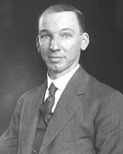Filming the naming of
the Federal Capital of Australia, Canberra
On the morning of Wednesday, 12 March 1913 a ceremony took place that is considered to be the starting point for the city of Canberra, Australia's Federal capital: three foundation stones of the Commencement Column, the first public construction on the site, were laid; and Lady Denman, the wife of the Governor-General, announced the officially-chosen name of the city-to-be.
The standard film of these events is Naming the Federal Capital of Australia, March 12th, 1913: The Ceremony, title number 9382 in the collection of the National Film and Sound Archive of Australia. This film was made by Raymond Hollis Longford and cinematographer Ernest Henry Higgins, and probably another cameraman (if not Longford himself, possibly Ernest Higgins' brother Arthur Embery Higgins), for Spencer's Pictures Ltd and to the order of the Commonwealth Department of Home Affairs.
The intertitles given to the scenes in the film are (with my numbering):
- The Hon. A. Fisher and Colonel Miller
- A group of Federal Ministers. Senators Howe, West, Finlayson and King O'Malley
- Senator Pearce (Minister for Defence) and General Bridges
- The Hon. W. Hughes Federal Attorney General
- Arrival of Her Excellency Lady Denman
- Arrival of the Governor General (Lord Denman) and suite
- The Field Battery firing the Royal salute
- His Excellency Lord Denman laying the foundation stone
- The Prime Minister (the Hon. A. Fisher) laying the second stone
- The Hon. King O'Malley laying the third stone
- Lady Denman naming the Capital "Canberra"
- Lord Denman and the Hon. A. Fisher proceeding to the saluting base
- The march past; Lord Denman at the saluting base
- The telegraphists at work sendning [sic] the news to Sydney; 200 words a minute; a record
- Panoramic view of site from Mt. Pleasant
The announcement of the name of the city was made by Lady Denman while standing
on a platform that was put on top of the base of the Commencement Column after
the foundation stones had been "well and truly laid".
With Lady Denman on this platform were her husband, the Governor-General, Lord Denman;
the Prime Minister, Andrew Fisher; and the Minister for Home Affairs, King O'Malley.
As per the ceremony programme,1 and according to both the official
book2 that recorded the event and contemporary newspaper reports,
after Lady Denman declared the name there was cheering from the onlookers
and a 21-gun salute by cannon, followed by the bands playing
Advance Australia and God Save the King (the National Anthem);
and after this the Prime Minister called for three cheers for Lady Denman.
The book says:
The enthusiasm evoked by the announcement made by Lady Denman was long
sustained, ...
.
What is shown in the relevant scene in the film, number 11 in the list above? The four persons on the platform are facing away from the grandstand; after about a second they all turn around to face the stand, and Prime Minister Fisher then calls for three cheers, as evidenced by three rounds of hats being waved. Obviously, the cheering of the crowd and the salute and most of the bands' playing have already occurred before the scene begins.
So despite the title of the film and the intertitle,
the scene starts minutes after Lady Denman had made her announcement.
The uttering of the few words by her –
I name the capital of Australia 'Canberra'
3 –
is not in the film. And there are obvious give-aways:
- Lady Denman's lips do not move in the first second or so;
- the time before the group turn around to face the stand is not enough for her to make the announcement;
- the people on the grandstand are quiet until prompted by the Prime Minister.
- Lady Denman made the declaration facing the specially invited guests in the grandstand, not away from them. This shows in photographs of her at the time she declared the name.4
- Lord Denman and the two men in bearskin caps (who are Major J.A.C. Quilter and Captain Sir Walter Barttelot) beside the column base are all saluting, because the National Anthem is being played; the salute is held for about a second, before the group turn around.
Whether the relevant section of film was long ago "souvenired", or whether
the cameraman did not start filming in time, or there was a problem with
the film or its processing is not known.
The programme for the day has the item Photographs and Cinematographic
pictures will be taken for historical record purposes.
following the
item for the bands' playing:
did the photographers and cinematographers take this literally to mean that they
were to wait before they started shooting?!
The still photograph image5 below was shot from a viewpoint close to
that from where scene 11 was filmed, and shows those on the column base
not long before the commencement of the scene in the film.
(Note Lord Denman and the two guards saluting.)
The inscription on the mount of the original photograph is:
Commencement Ceremony, 12th March, 1963 [sic] The National Anthem,
after the Federal City has been named
.
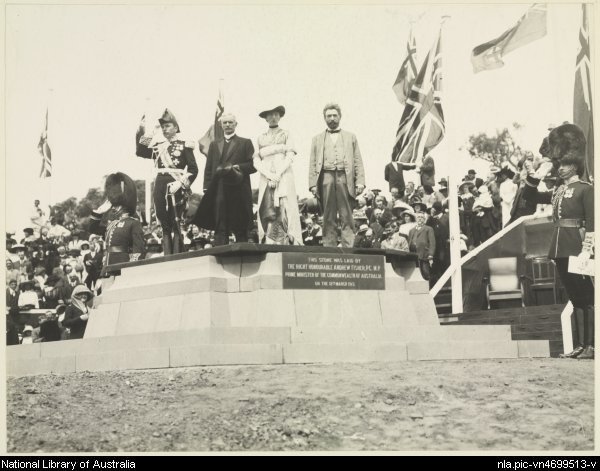
Playing the National Anthem at the Canberra naming ceremony, 12 March 1913.
Those on the base of the Commencement Column are, from left to right:
the Governor-General, Lord Denman; the Prime Minister, Andrew Fisher;
Lady Denman; and the Minister for Home Affairs, King O'Malley.
(Photograph by William J. Mildenhall)
The National Film and Sound Archive of Australia, for the centenary (in March 2013) of these events, produced a digital version of the original film, which is accessible online. This is a superb copy and has been painstakingly restored and dust-busted, and looks as good as new.
(The australianscreen Web site has a clip of scene 11 (with particularly facile comments) which has been thoughtlessly and needlessly cropped.)
Several of the still photographs of the event, as well as Spencer's film, show cameramen at work. In the image below, three still photographers with cameras can be seen and, on a tripod, a cinecamera, though the cinematographer is mostly hidden. The photograph was taken at the time Lord Denman was laying the first foundation stone, and because the cinecamera is in a position that appears to have the field of view seen in the film, it is almost certainly that of a Spencer's Pictures operator.
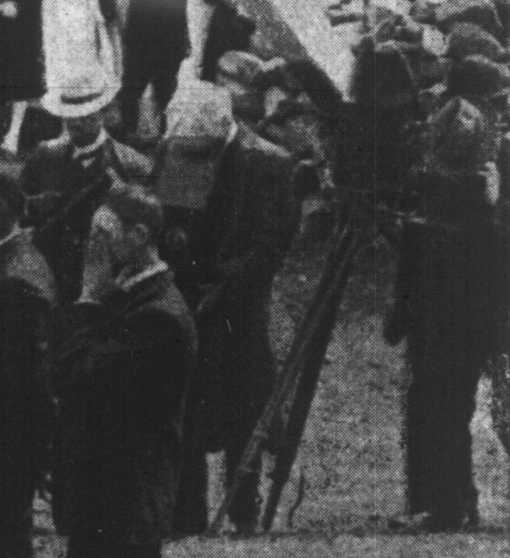
Close-up from the scene when Lord Denman was laying the first foundation stone
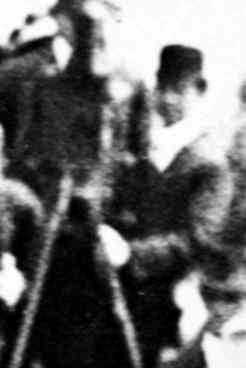 Possibly Arthur Higgins at the Canberra naming ceremony (Detail from photograph by Frank H. Boland) Image courtesy of the National Library of Australia
Enlargement kindly provided by Brian Dunne
|
Some of the scenes (5, 6, and 7) in the Spencer's film were shot from the west end of the grandstand, which is where the cinecamera in the image6 on the left is positioned; other scenes were taken on the ground, as in the image above.
Image courtesy of the State Library of New South Wales
| |||
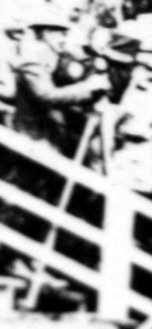 James P. Campbell filming at the Canberra naming ceremony (Detail from photograph by Frank H. Boland) Image courtesy of the National Library of Australia
Enlargement kindly provided by Brian Dunne
| ||||
|
Another cinecameraman shooting at the ceremony was the official Commonwealth Government cinematographer, James Pinkerton Campbell.7 He was employed by the advertising branch of the Department of External Affairs, who sent him from Melbourne without knowing that the Department of Home Affairs had engaged Spencer's to film the ceremony. Campbell was also given a prime position on the grandstand, at the east end. What became of his film is not known; he gave some of it to Pathé Frères, and this was probably used in one of their gazettes. Campbell appears in a still photograph8 of the ceremony - see the image on the right. And he can also be seen cranking his camera in the background of scenes 6, 7, and 11 of the Spencer's Pictures film. | ||||
Were there any more cinematographers at the ceremony?
The Yass Courier newspaper states that
[t]here were three dozen cameras, including biographs, continually in use
throughout the proceedings
,9 so possibly there were.
The Department of Home Affairs originally wanted Pathé Frères to do the filming,
but Spencer's offered a far better deal and so were chosen.
As Pathé showed the ceremony in one of their Australian Gazettes, they
may have had their cameraman there anyway, or they may have used some of
Campbell's film as mentioned above.
Exhibitions of the films
King O'Malley consented to Spencer's film of the ceremony being shown at the Jubilee Theatre in Nicholson St, North Carlton, Melbourne on the evening of 13 March, but reportedly the copy was erroneously sent to Sydney instead of Melbourne.10 More likely, the exposed film went to Sydney to be processed and a finished print wasn't available in time to be sent (by train) to Melbourne.
Spencer's film was shown publicly for the first time on Wednesday, 19 March
at Spencer's Lyceum in Sydney.
Advertisements named the scenes in the film as:
Getting to the site;
Distinguished Guests;
Federal Ministers;
Arrival of Vice-Regal Party;
Laying the Foundation-stones;
Naming the Capital;
Telegraphists at Work;
Military Review;
Panorama of the District.11
This suggests that the film shown had the scenes in a slightly different order
from that in the existing film (see list above).
The film was only run for a week, finishing at that theatre on
Wednesday, 26 March.
The Sydney Morning Herald remarked of the 22 March showing:
One fault in the screening, however, caused everyone to move too fast. The impression was conveyed that after the ceremony the Governor-General, Lady Denman, Mr. Fisher, and Mr. O'Malley were seeking shelter from a shower of rain.12(This must have been the projectionist's fault, cranking too fast.)
J. D. Williams' Crystal Palace theatre in Sydney also showed the Spencer film, but only on 20 and 22 March.13
Melbourne got to see a film on 31 March at the Majestic Theatre, which was managed by Amalgamated Pictures Ltd; later it was mostly only shown at matinees.14 Presumably this was Spencer's film, but Pathé's Australian News [Gazette] was also on the bill, so possibly the film of the naming ceremony was from Pathé. Other Melbourne cinemas showed a film of the ceremony early in April.15
As part of the Federal Government's campaign for a coming election, Senator Allen McDougall (of New South Wales) presented films and photographs taken by James P. Campbell while on a tour of the Northern Territory in April and May 1912. Campbell's Canberra film was also shown at these exhibitions.16
The Swastika Electric Picture Company showed Spencer's film at the Protestant
Hall, Queanbeyan, New South Wales on 7 April 1913 and after,
claiming they were the first to show it outside the metropolis
.17
Pathé's version (in their Gazette) was shown at Queanbeyan's Triumph Pictures
the following night, possibly also with Spencer's.18
During April and May 1913, the Spencer's film or the Pathé film was shown at cinemas around the country.
References and notes
[1] National Archives of Australia: M4071, 44:
Sheaffe Papers. Laying the Foundation Stones of the Commencement Column
at the Federal Capital City. Programme. 12th March 1913.
[2] Canberra: Capital City of the Commonwealth of Australia. Laying the Foundation Stones of the Commencement Column and Naming the Federal City. 12th March, 1913.; A. J. Mullet, Government Printer, Victoria, [1913].
[3] Lady Denman's exact words are not certain.
Some reports state that she said: I name the capital city of Australia 'Canberra'
.
[4] There are also photographs of her facing away from the stand that are titled "Lady Denman naming the Capital" or similar. But, as with the film, these were likely all that were available that looked like Lady Denman actually making her declaration.
[5] Details at http://nla.gov.au/nla.pic-vn4699513.
[6] Details at http://nla.gov.au/nla.pic-an23763470.
[7] Campbell's efforts at the naming ceremony were the subject of criticism,
and together with supposed unsatisfactory work on other occasions were used as
the excuse for his dismissal in April 1913.
His supervisor, David B. Edward, wrote:
Part of the Canberra film is good, some of it is poor, and a great deal of it
is useless.
Campbell refuted this, though too late to save his job.
Campbell's problems at the inauguration ceremony were not, from his account, really his fault. He was sent on short notice, without accommodation previously arranged; there was no or little introduction organised to those running the ceremony, and they resented the appearance of a latecomer; and he was expected to take both still photographs and motion pictures on his own.
[8] Details at http://nla.gov.ay/nla.pic-an23763447.
[9] 13 March 1913, Yass Courier, p.2def, CANBERRA, The Capital's Christening.
[10]
13 March 1913, The Age (Melbourne), p.10b,
PICTURE FILM OF CEREMONY.
14 March 1913, The Age (Melbourne), p.7g,
PICTURE FILM GOES ASTRAY.
[11] 18 March 1913, The Sydney Morning Herald, p.2f, AMUSEMENTS, SPENCER'S LYCEUM.
[12] 24 March 1913, The Sydney Morning Herald, p.4g, AMUSEMENTS, SPENCER'S THEATRE.
[13]
20 March 1913, The Sydney Morning Herald, p.2e,
AMUSEMENTS, IN THE FAMOUS PICTURE BLOCK;
22 March 1913, The Sydney Morning Herald, p.2g,
AMUSEMENTS, IN THE FAMOUS PICTURE BLOCK
[14] 31 March 1913, The Age, p.8e, AMUSEMENTS.
1 April 1913, The Age, p.16c,
AMUSEMENTS, MAJESTIC THEATRE
[15] e.g. 2 April 1913, The Age, p.16e, AMUSEMENTS, BRITANNIA THEATRE.
[16] 5 April 1913, The Mercury (Hobart), p.5, GENERAL TELEGRAMS.
[17] 4 April 1913, Queanbeyan Observer, p.2e,
THE CAPITAL CITY OF AUSTRALIA.
4 April 1913, Queanbeyan Observer, p.2f,
SWASTIKA ELECTRIC PICTURES
8 April 1913, Queanbeyan Observer, p.3a,
THE BEST IN PICTURES.
|
Copyright © 2012 – 2024 Tony Martin-Jones | FILM HISTORY INDEX |
Edition 3 (2024-11-17) [First edition in 2012-10] |
